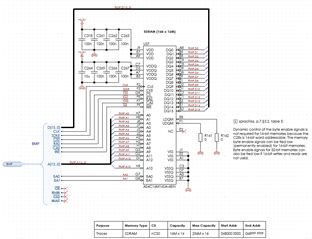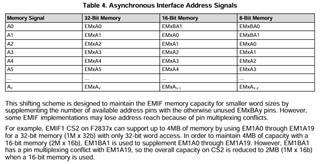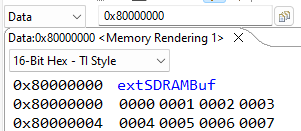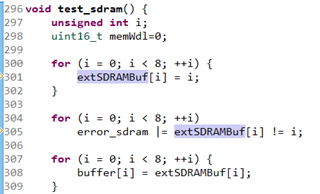Tool/software:
I designed a board including external memory on EMIF2 copying the F28379D_EMIF_DC reference design.

The SDRAM is configured with the following code:
void configure_sdram() {
// Do not synchronize the EMIF2 pins
for (unsigned i = 53; i <= 68; i++) {
GPIO_setPadConfig(i, GPIO_PIN_TYPE_PULLUP);
GPIO_setQualificationMode(i, GPIO_QUAL_ASYNC);
}
GPIO_setPinConfig(GPIO_68_EMIF2_D0);
GPIO_setPinConfig(GPIO_67_EMIF2_D1);
GPIO_setPinConfig(GPIO_66_EMIF2_D2);
GPIO_setPinConfig(GPIO_65_EMIF2_D3);
GPIO_setPinConfig(GPIO_64_EMIF2_D4);
GPIO_setPinConfig(GPIO_63_EMIF2_D5);
GPIO_setPinConfig(GPIO_62_EMIF2_D6);
GPIO_setPinConfig(GPIO_61_EMIF2_D7);
GPIO_setPinConfig(GPIO_60_EMIF2_D8);
GPIO_setPinConfig(GPIO_59_EMIF2_D9);
GPIO_setPinConfig(GPIO_58_EMIF2_D10);
GPIO_setPinConfig(GPIO_57_EMIF2_D11);
GPIO_setPinConfig(GPIO_56_EMIF2_D12);
GPIO_setPinConfig(GPIO_55_EMIF2_D13);
GPIO_setPinConfig(GPIO_54_EMIF2_D14);
GPIO_setPinConfig(GPIO_53_EMIF2_D15);
GPIO_setPinConfig(GPIO_97_EMIF2_DQM0);
GPIO_setPinConfig(GPIO_96_EMIF2_DQM1);
GPIO_setPinConfig(GPIO_98_EMIF2_A0);
GPIO_setPinConfig(GPIO_99_EMIF2_A1);
GPIO_setPinConfig(GPIO_100_EMIF2_A2);
GPIO_setPinConfig(GPIO_101_EMIF2_A3);
GPIO_setPinConfig(GPIO_102_EMIF2_A4);
GPIO_setPinConfig(GPIO_103_EMIF2_A5);
GPIO_setPinConfig(GPIO_104_EMIF2_A6);
GPIO_setPinConfig(GPIO_105_EMIF2_A7);
GPIO_setPinConfig(GPIO_106_EMIF2_A8);
GPIO_setPinConfig(GPIO_107_EMIF2_A9);
GPIO_setPinConfig(GPIO_108_EMIF2_A10);
GPIO_setPinConfig(GPIO_109_EMIF2_A11);
GPIO_setPinConfig(GPIO_95_EMIF2_A12);
GPIO_setPinConfig(GPIO_111_EMIF2_BA0);
GPIO_setPinConfig(GPIO_112_EMIF2_BA1);
GPIO_setPinConfig(GPIO_113_EMIF2_CAS);
GPIO_setPinConfig(GPIO_114_EMIF2_RAS);
GPIO_setPinConfig(GPIO_115_EMIF2_CS0N);
//GPIO_setPinConfig(GPIO_110_EMIF2_WAIT);
//GPIO_setPinConfig(GPIO_116_EMIF2_CS2N);
GPIO_setPinConfig(GPIO_117_EMIF2_SDCKE);
GPIO_setPinConfig(GPIO_118_EMIF2_CLK);
//GPIO_setPinConfig(GPIO_119_EMIF2_RNW);
GPIO_setPinConfig(GPIO_120_EMIF2_WEN);
//GPIO_setPinConfig(GPIO_121_EMIF2_OEN);
SysCtl_setEMIF2ClockDivider(SYSCTL_EMIF2CLK_DIV_2);
SysCtl_configureType(SYSCTL_MEMMAPTYPE, 0x1U, 0x1U);
// Allow CPU and DMA access to EMIF2
EMIF_setAccessProtection(EMIF2CONFIG_BASE, 0x0);
EMIF_commitAccessConfig(EMIF2CONFIG_BASE);
EMIF_lockAccessConfig(EMIF2CONFIG_BASE);
// Apply timing parameters
EMIF_SyncTimingParams syncTimingParams;
syncTimingParams.tRfc = 6; // Refresh to Active/Refresh command delay
syncTimingParams.tRp = 1; // Precharge to Activate delay
syncTimingParams.tRcd = 1; // Activate to Read/Write delay
syncTimingParams.tWr = 2; // Write recovery time
syncTimingParams.tRas = 4; // Active to Precharge delay
syncTimingParams.tRc = 6; // Active to Active/Auto Refresh delay
syncTimingParams.tRrd = 1; // Activate to Activate delay (different banks)
EMIF_setSyncTimingParams(EMIF2_BASE, &syncTimingParams);
// Set the self-refresh timing (often 64 ms, but here 7.8 us)
EMIF_setSyncSelfRefreshExitTmng(EMIF2_BASE, 0x7U);
EMIF_setSyncRefreshRate(EMIF2_BASE, 781); // 7.81 us
// Configure structure for EMIF2
EMIF_SyncConfig syncConfig;
syncConfig.casLatency = EMIF_SYNC_CAS_LAT_2;
syncConfig.iBank = EMIF_SYNC_BANK_4;
syncConfig.narrowMode = EMIF_SYNC_NARROW_MODE_TRUE; // 16-bit mode
syncConfig.pageSize = EMIF_SYNC_COLUMN_WIDTH_9;
EMIF_setSyncMemoryConfig(EMIF2_BASE, &syncConfig);
}
Using this test function I noticed a weird behavior:
__attribute__((far)) volatile uint16_t sdram_buffer[8];
volatile uint16_t buffer[8] = {0};
volatile bool error_sdram = 0;
void test_sdram() {
for (unsigned i = 0; i < 8; ++i) {
sdram_buffer[i] = i;
}
for (unsigned i = 0; i < 8; ++i)
error_sdram |= sdram_buffer[i] != i;
for (unsigned i = 0; i < 8; ++i) {
buffer[i] = sdram_buffer[i];
}
}
The values in `buffer` are:
1, 1, 3, 3, 5, 5, 7, 7
I noticed from SPRAC96A :

In which we have a shift for 16-bit memory.
What is the correct way? F28379D_EMIF_DC with the 16-bit SDRAM or Table 4 from SPRAC96A?
I would like to find the best way to fix my design or the code.




